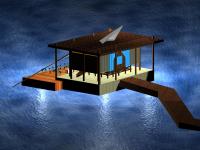This is a project that has been designed fot the `Central Glass International Architectural Competition`, a competition that is launched each year with a different theme. `The Boathouse on the Lake` is an answer for the year 2004 where the competition theme has been chosen as `The AsiaFront Village`.
In this competition, the competitor is free to determine the type of the building where it can be located anywhere in the world, either in a city or the suburbs. It can be consolidated into one facility, or it can be an internetional conference facility or training center, a lodging or complex facility. But it ought to be a place of the unique culture interspersed throughout Asia.
Here, it must be recognized that in all parts of Asia throughout the ages, while each has possessed a unique culture, there is also an exchange of culture through routes such as Silk Road. Although this road has not served to integrate culture, it encouraged people living there to nurture the original culture of thier own land. Keeping these issues in mind, `The AsiaFront Village` must renew appreciation of the difference in such cultures and to use it as nourishment for a new age due to yhe globalization of information, communication and transport of the present age.
So, the design of a boathouse together with its bungalows has been decided to survey the culture of the 21th century, as the proposals have been asked to be full of originality, including the program design.The result is a demure building that is floating on a lake, keeping the volume as simple as possible by creating a box structure which is an icon of the 20th century modern movement. This box structure is elevated on coloumns, opening space for the boats underneath and making them possible to be viewed both from the inside and outside restaurants as objects of interest. This viewing achieved from the upper first floor through a glass flooring. The pointed arch shape of the windows, the use of turquoise ceramic tiles on the elevation and a lattice canopy over the building, casting oriental hexagonal shadows below, all refers to the architecture which can be seen throughout a journey along the Silk Road. Finally, the shading of the outside restaurant is made possible by the design of a tent structure attributing to the nomadism, taking an important place in Asian culture.
2004
.jpg)
.jpg)

.jpg)



.jpg)
